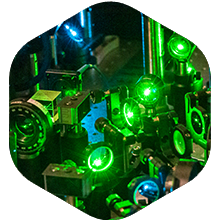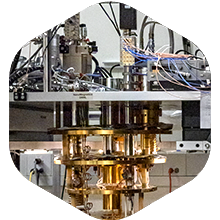Scientific Thrusts
The QSC is organized into three thrusts to meet its overarching goal. Each thrust comprises specific aims that address closely linked research areas designed to balance lower-risk, near-term goals that leverage existing quantum technologies to probe, simulate, and improve understanding of quantum phenomena with long-term goals of achieving revolutionary breakthroughs in topological protection and manipulation of quantum information.

Thrust 1: Quantum Materials Discovery and Developm
Thrust 1 will demonstrate and control non-Abelian anyon states relevant to QIS in real materials. These states are expected to exist in electronic materials with nontrivial topologies and magnetic systems with entangled quantum spins, and the topological protection and delocalization of the states that make them attractive for QIS applications can also make them difficult to probe and to understand. Thus, research in this thrust is focused on understanding and developing topological electronic materials, quantum spin systems, and quantum probes.
Led by ORNL’s Michael McGuire

Thrust 2: Quantum Algorithms and Simulation
Thrust 2 will achieve predictive capabilities for the study of strongly coupled quantum systems, including topological systems and quantum field theories, and develop and test quantum algorithms for quantum-limited sensors. To achieve this goal, QSC researchers are developing efficient, scalable, and robust quantum simulation and metrology algorithms, testing these algorithms in predictive dynamical quantum simulation and quantum sensing applications, and developing software tools to support algorithm analysis, optimization, and implementation.
Led by LANL’s Andrew Sornborger

Thrust 3: Quantum Devices and Sensors for Discover
This thrust will develop an understanding of fundamental sensing mechanisms in high-performance quantum devices and sensors. This understanding will allow QSC researchers, working across the Center, to co-design new quantum devices and sensors with improved energy resolution, lower energy detection thresholds, better spatial and temporal resolution, lower noise, and lower error rates. Going beyond proof-of-principle demonstrations, the focus will be on implementation of this hardware in specific, real-world applications.
Led by Fermilab’s Aaron Chou
